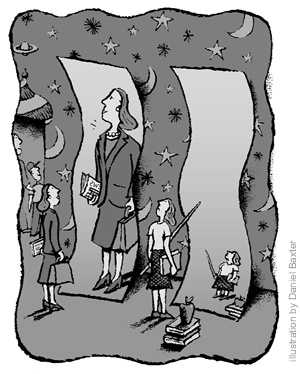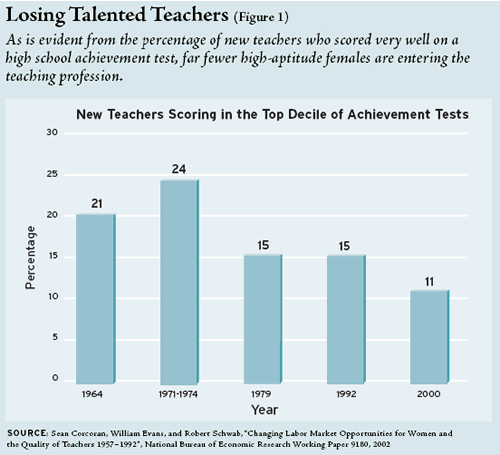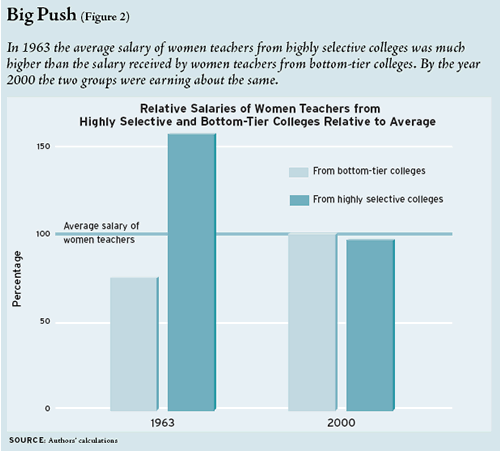
Though exceptions undoubtedly exist, women with higher aptitudes can ordinarily be expected to be more effective classroom teachers than those with lower aptitudes. It is therefore troubling to think that in the United States those entering the teaching profession in recent years have, on average, lower measured aptitudes than their predecessors.
That able women are no longer entering the teaching profession at anywhere near the same rate as in the past is of special concern, since women compose approximately 75 percent of all elementary and secondary school teachers, almost the same percentage as 40 years ago.
Yet a decline in female teacher quality is just what the evidence-most notably a recent study by three University of Maryland economists-indisputably shows (see Figure 1). According to their findings, the likelihood that a highly talented female (one ranked among the top 10 percent of all high schoolers) will become a teacher fell from roughly 20 percent in 1964 to just over 11 percent in 2000.

The study gives weight to other signs that the teaching profession no longer attracts exceptional teachers. Dr. Leo Klagholz, a commissioner of education in New Jersey in the 1990s, surveyed his state’s teacher colleges in the 1980s and found that, for prospective teachers, the verbal and math SAT scores, when combined, were lower than 800 out of a possible score of 1,600. Similarly, the Educational Testing Service in 1990 found that those expressing an intention to become a teacher scored near the bottom among those taking the test. In 1998, Eugene Hickok, then Pennsylvania’s secretary of education, revealed that his state’s teacher preparation system provided “limited assurances of competence and quality,” leaving “the doors-open for C-plus students (or worse) to become teachers.”
The icing on the anecdotal cake came in the summer of 2003 with news that a Massachusetts superintendent of education, Wilfredo Laboy, had failed-for the third year in a row-a literacy test that the state’s high school seniors needed to pass in order to graduate. The exam Laboy failed has been part of a series of tests required of new Massachusetts teachers since 1998. It was also big news when aspiring teachers took the tests for the first time: almost 60 percent of them flunked. Paul Reville, director of the Rennie Center for Education Research & Policy at MassINC, a nonpartisan think tank in Boston, reviewed many of the written responses from those who failed and bemoaned the high number of the commonwealth’s teachers “who were college graduates and yet couldn’t string a sentence together.”
What Accounts for the Decline in Teacher Quality?
The factors contributing to the reduced likelihood that women of high aptitude will enter the teaching profession appear to come from both within and outside the teaching profession. We focus on two that can be expected to be of critical significance.
First, within the teaching profession, the pay scale of public school teachers has become increasingly compressed since the 1960s. The salary distribution has narrowed so that those with the highest aptitude earn no more than those with the lowest. This may have pushed able women out of the field of education.
Second, outside of teaching, college-educated women have achieved greater parity in their pay vis-à-vis male workers, luring more able women to alternative professions. High-aptitude women may have pulled away from education in order to take special advantage of the new opportunities.
While there could be other explanations outside our investigation, conventional wisdom has long pointed to new opportunities for college-educated women as the primary explanation for the change in teacher quality that many have sensed. We were inclined to accept the conventional wisdom when we began this project, but, after systematically comparing the relative importance of the two factors, we found, surprisingly enough, that pay compression within the teaching profession, induced by the introduction of collective bargaining, has had by far the greater effect.
On further reflection, we were not quite so surprised by the results. For one thing, the overall timing of the decline in teacher quality corresponds to the rise of collective bargaining within education. Teacher unions won collective bargaining rights in key cities and states during the 1960s. Over the next 20 years, collective bargaining spread from state to state across the country.
As a result of union action, the average salary for teachers increased modestly. But as the average was edging upward, the range of the scale narrowed sharply, so much so that able young women were bound to take notice. Moreover, collectively bargained contracts placed a premium on characteristics such as seniority and credentials rather than performance, further depressing the opportunities for the high-aptitude teacher.
Our Approach
Women may enter teaching for any number of reasons, some of which are obviously intangible. We began our study by making the standard economic assumption that a woman’s decision to teach is influenced in part by her expected pay within teaching and her expected pay in other occupations. We then subdivided each of these expectations, developing four components that affect the occupational choices of female college graduates:
1. the average pay of all teachers;
2. the differences between the average pay of all teachers and those having a particular aptitude (a measure of pay compression);
3. for all other occupations, the average pay for men with particular aptitudes (what might be considered the base pay for that occupation);
4. for all other occupations, the difference between this base pay for men with a particular aptitude and the pay received by women with comparable aptitudes (pay parity).
Although compression of pay within teaching and improved parity with pay for women in other occupations occurred simultaneously over the past 40 years, we were able to distinguish their independent effects, because the timing of their impact varied considerably from one state to the next. For example, parity of pay for women improved sooner in some states than in others. Since we had data, by state, on the earnings of men and women who graduated from college in the same year, we could estimate the independent impact of pay parity separately for each state by calculating the ratio of female-to-male earnings of nonteachers who graduated from similar colleges at the same time.
The rate of change in the degree of wage compression due to union influences also varied from one state to the next. For instance, while teachers in states like Michigan, Massachusetts, and Rhode Island were heavily unionized by the early 1960s, collective bargaining spread more slowly in other states-especially in the South. These differences were largely due to differences in state laws relating to collective bargaining for public-sector workers.
Unionization and the introduction of collective bargaining can be expected to increase average pay for all teachers but reduce the difference between average pay and the pay received by those with both high and low aptitudes, thereby discouraging entry into teaching by women with higher aptitude while attracting those with lower aptitudes. While other forces may also affect the wage spread, we have isolated statistically the portion that was caused by unionization and collective bargaining. To do so, we relied on six indicators of state laws that facilitated or forestalled unionization of teachers. From 1955 onward, states gradually enacted laws that gave teachers’ organizations the rights to meet and confer with management, to conduct collective bargaining, to deduct members’ dues and nonmembers’ fees from paychecks, and to exclude nonmembers from teaching. Other states enacted laws that protected nonmembers’ right to work or prohibited paycheck deduction of dues and fees.
Other research shows that changes in these laws caused the pace of teachers’ unionization to vary considerably, even among states with very similar labor markets such as Ohio and Illinois. By restricting our analysis to changes in unionization that were associated with changes in state laws, we can be confident that we are identifying the effect on pay compression of unionization alone.
The Data
We limit our analysis to college graduates, since a college degree was required for almost all beginning teachers during the 40-year period of our study. The data come from a series of surveys conducted by the federal government for various years between 1961 and 1997. For the college graduating classes of 1975, 1977, 1980, 1984, 1986, and 1990, we relied on the surveys of Recent College Graduates (RCG), compiled by the U.S. Office of Education (later the Department of Education). For information on the classes of 1961 and 1964 to 1967, we relied on two predecessors of the RCG surveys (College Graduates of the Class of 1961 and Project Talent), and two successors to the RCG surveys (Baccalaureate and Beyond and the National Education Longitudinal Study) provide information for the classes of 1993 and 1997.
The surveys contained information, for most states, on the college from which a woman graduated, her first occupation, and her earnings around one to three years after graduation. Unfortunately, the surveys did not collect direct information on a woman’s aptitude. However, we were able to obtain information on the average aptitude of all students at the college she attended.
We divide the individuals from each annual cohort of college graduates into six groups according to the type of school attended: 1) highly selective colleges, where average student SAT scores were in the top 5 percentiles; 2) quite selective colleges, in the next 10 percentiles; 3) moderately selective colleges, in the next 15 percentiles; 4) above-average colleges, in the next 20 percentiles; 5) below-average colleges, in the next 25 percentiles; and 6) bottom-tier colleges, in the lowest 25 percentiles.
Organizing in this way gave us a direct measure of the extent to which teachers are being trained at more or less selective colleges, itself a question of considerable interest. The measure also provides an accurate estimate of the change in the aptitude of entering teachers, provided that their average aptitude relative to the average aptitude of all students has not changed within each of these six categories over time. That is, if the average teacher’s SAT score at highly selective colleges is consistently 50 points lower (or higher) than that of the average student at such colleges, and a similar consistency holds for the other groupings, then we have a good measure of changes in the aptitudes of those entering the teaching profession.
Charting the Decline
The economic news for educators as a whole was fairly good over the approximately 40 years of the study. Our data indicate that, nationwide, the real (inflation-adjusted) earnings of the average new female teacher rose by 8 percent between 1963 and 2000. But this change was not evenly distributed across aptitude groups. The earnings of teachers in the lowest aptitude group (those from the bottom-tier colleges) rose dramatically relative to the average, so that teachers who in 1963 earned 73 percent of the average salary for teachers could expect to earn exactly the average by 2000. Meanwhile, the ratio of the earnings of teachers in the highest-aptitude group (from the highly selective colleges) to earnings of average teachers fell dramatically. In states where they began with an earnings ratio of 157 percent, they ended with a ratio of 98 percent. By 2000, most states had earnings ratios near 100 percent for all aptitude groups, indicating that graduates of the most highly selective colleges earned no more as teachers than did graduates from bottom-tier schools! (See Figure 2.)

Opportunities outside of teaching also changed differently for women by ability group, but the differences were far less pronounced. For a college graduate from the selective schools (the top 30 percent), the ratio of female earnings to male earnings in nonteaching occupations rose modestly: A woman could expect her earnings to rise as a percentage of the earnings of males with similar aptitudes from 77 percent in 1963 to 84 percent in 2000. For a woman from the bottom-tier schools, there was little change in the ratio of female earnings to male earnings. A woman could expect her earnings to drop slightly, from 80 to 77 percent, in relation to men with similar aptitude (see Figure 3).

Our data also indicate that the share of new female teachers from highly selective colleges fell from 5 percent to 1 percent between 2000 and 1963. This five-fold drop is a strong indication in our data of the decline in teacher aptitude. Over the same period, the share of new female teachers who came from the bottom-tier colleges rose from 16 to 36 percent (see Figure 4).

Equal Effects, Unequal Consequences
Factors with equal potential effects can nonetheless have dramatically different consequences if one factor hardly changes while the other shifts significantly. In physics, both pressure and temperature affect volume, but if only temperature changes, that is the force that explains why a kettle whistles when water comes to a boil. As we shall see, much the same can be said about changes in teacher quality in recent decades.
Equal changes in each of the four components listed above had roughly equal effects on the probability that a woman would enter the teaching profession. For example, increases in average teachers’ salaries increased the likelihood that a woman would become a teacher. Changes in other occupations had a similar effect. When the base occupational wages (for men) within a particular aptitude group increased, then women were attracted out of teaching to other occupations. Also, when women came closer to achieving parity of pay in nonteaching occupations, then teaching became less attractive. A change in any of these factors had roughly the same impact on the decision of women to enter teaching as did a change in the amount of wage compression.
But while an equal change in all factors would have had a roughly similar impact on the chances that women of a particular aptitude would choose to teach, the actual size of the changes over the 40-year period were anything but equal for women from different aptitude groups. While parity of pay for men and women and the base pay for males in other occupations changed similarly for all women regardless of aptitude, the change in union-induced compression of the pay spread for teachers was especially large.
As a result teaching became much more attractive to those with lower aptitudes-and much less attractive to the most talented. Pay compression increased the share of the lowest-aptitude female college graduates who became teachers by about 9 percentage points. Meanwhile, the share of the highest-aptitude graduates who became teachers shifted downward by about 12 percentage points.
By contrast, the gains in gender equality in other occupations, while significant, were similar for female college graduates of all aptitudes. Thus they had only small differential effects on the occupational choices of talented women college graduates; the fraction of women entering the teaching profession from highly selective colleges fell by only 3.2 percentage points. For all the selective colleges (the top 30 percent), the effect was just 2.5 percentage points. For all those who attended less selective colleges, increasing pay parity had negligible effects.
Conclusions
The results reported above allow us to estimate how many teachers would have come from each type of college had pay compression not intensified and, separately, had pay parity in other occupations not improved. We find that pay compression explains about 80 percent of the decline of teachers from highly selective colleges and about 25 percent of the increase in the share of teachers from the least selective colleges. Meanwhile, changes in pay parity in nonteaching occupations explains only 9 percent of the decline in the share of teachers coming from highly selective colleges-and only 6 percent of the increase in teachers from the bottom tier of colleges. The sheer increase in the proportion of all college graduates coming from these bottom-tier colleges accounts for much of the remaining increment in the percentage of low-aptitude teachers.
These results are striking: union-driven pay compression alone accounts for more than three-quarters of the decline in teacher quality. The finding is best understood by recognizing that pay parity increased only moderately and at a similar rate for college-educated women of all abilities. Not only did the gender gap begin to disappear in such highly paid professions as law and medicine, but it also slipped noticeably in less-exalted occupations such as bookkeeping and middle-level administration.
Put another way, we cannot expect high-performing college graduates to continue to enter teaching if that is the one profession in which pay is decoupled from performance. Indeed, other professions have been raising the reward for performance over the past few decades. We suspect that this trend exacerbated the degree to which pay compression pushed high-aptitude people out of teaching. A push from one direction has more effect on someone who is being simultaneously pulled from the other direction.
Our findings, though disturbing, are potentially hopeful. The decline in the quality of those entering teaching is not an irrevocable trend driven by larger forces in the society over which policymakers can exercise little control. On the contrary, education policymakers have the tools within their own hands to address the problem at hand. To attract high-aptitude women back into teaching, school districts need to reward teachers in the same way that college graduates are paid in other professions-that is, according to their performance. In all probability, such a strategy would attract male teachers of higher aptitude as well.
Caroline M. Hoxby is professor of economics at Harvard University and the director of the Economics of Education Program at the National Bureau of Economic Research. Andrew Leigh is an economist in the Research School of Social Sciences at the Australian National University.
The unabridged version of this article is available at www.educationnext.org.
This article appeared in the Spring 2005 issue of Education Next. Suggested citation format:
Hoxby, C.M., and Leigh, A. (2005). Wage Distortion: Why America’s Top Female College Graduates Aren’t Teaching. Education Next, 5(2), 50-56.


